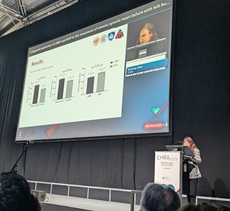
A left bundle branch pacing (LBBP) approach has been shown to be superior to biventricular pacing with regard to reducing long-term all-cause mortality and heart failure hospitalisation (HFH), according to new data showcased at the European Heart Rhythm Association (EHRA) congress (30 March–1 April 2025, Vienna, Austria).
Presenting late-breaking findings from the multicentre, prospective HeartSync-LBBP randomised controlled trial (RCT), Xueying Chen (Zhongshan Hospital, Shanghai, China) informed the audience that the study set out to evaluate and compare the treatment of chronic systolic HF with these two pacing modalities.
The study—which Chen noted is currently the largest of its kind assessing LBBP versus biventricular pacing among HF patients with left bundle branch block (LBBB)—enrolled a total of 200 participants across six Chinese centres, randomising these participants 1:1 to an LBBP group or a biventricular pacing group between October 2020 and March 2022.
The primary endpoint of the HeartSync-LBBP RCT was a composite outcome combining all-cause mortality and HFH, while secondary endpoints included outcomes relating more specifically to all-cause mortality, HFH, or echocardiographic responses measured via left ventricular ejection fraction (LVEF) changes.
Chen relayed that, at a median follow-up timepoint of 36 months, all 100 patients in both study groups were available for intention-to-treat analyses.
Moving on to disclose the trial’s results, she reported that QRS durations decreased compared to baseline in the LBBP group (from 169.8 to 120.6 milliseconds; p<0.01) and the biventricular pacing group (from 167 to 137.4 milliseconds; p<0.01)—however, of the two, LBBP achieved the greater reduction, as per a paced QRS duration of 120.6 milliseconds versus 137.4 milliseconds with biventricular pacing (p<0.01).
In addition, regarding echocardiographic measurements at both six months and final follow-up, LVEF percentages increased more significantly with LBBP versus biventricular pacing, with this trend also being seen regarding left ventricular end-systolic diameter (LVESD) and left ventricular end-diastolic diameter (LVEDD) calculations.
Chen went on to state that, in the trial, response rates (LVEF improvement ≥5%) were similar between LBBP and biventricular pacing at the six-month/final follow-up timepoints, but ‘super-response’ rates (LVEF improvement ≥15% or LVEF ≥50%) were significantly higher with LBBP.
“As for the primary endpoint, intention-to-treat analysis showed that the LBBP group had a significantly lower incidence of all-cause mortality and HFH [p<0.01; hazard ratio, 0.26],” Chen commented, also reporting that subgroup analyses revealed LBBP to be superior to biventricular pacing regardless of variations in age, sex, hypertension, baseline QRS duration, LVEF, and non-ischaemic cardiomyopathy (NICM).
In terms of individual assessments of HFH and all-cause mortality, the former found a statistically significant reduction with LBBP versus biventricular pacing (p<0.01; hazard ratio, 0.23), but the latter detected no statistically significant difference between the two modalities (p=0.25; hazard ratio, 0.4).
Prior to concluding, Chen alluded to multiple limitations of the HeartSync-LBBP study—including a high percentage of male patients and patients with NICM being enrolled, and the fact that the study only saw participation from Chinese patients and only involved treatments at experienced centres, all of which may restrict the generalisability of its findings.
Nevertheless, she added: “In this long-term, randomised clinical trial, LBBP demonstrated greater electrical, mechanical and haematological improvements than biventricular pacing in heart failure patients with LBBB, and [LBBP] is therefore an alternative to binary pacing.”









